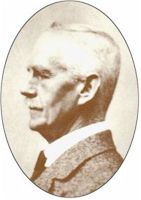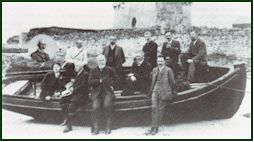| 1. Symposia / Historical Safaris
3. Research 4. Surveys
7. Folklore 9. Contact us 11. Links |
First Clare Island Survey (1911 - 1915)
Clare Island was studied intensively and from almost every
angle some eighty years ago. Between the years 1909 to 1911, the island was the subject of
the largest and most comprehensive natural history survey ever During the second decade of the century, groups of
fieldworkers numbering anything from six to sixteen were sent to the island at monthly
intervals through spring, summer and autumn. All in all, over the three year period more
than 100 workers took part. Volunteers from England, Scotland, Germany, Denmark and
Switzerland participated, as well as Ireland's leading field naturalists.From the
perspective of the islanders, this influx of scientists must have seemed at times to have
been an invasion. A few of the oldest residents can still relate stories which recount
strange meetings with oddly dressed men in the most unlikely parts of the islands armed
with butterfly nets and jam jars.
During the years previous to the Survey, Clare Island had experienced quite radical social and economic change. The islanders had become land owners only ten years before, buying their newly 'striped' and fenced holdings from the Congested Districts Board (CDB). Only the third acquisition by the Board, Clare Island was purchased from its last landlord in 1895. Over the next six years, the CDB implemented a radically progressive project of social engineering and local development. In addition to the reorganisation of farms through the 'striping' of the arable land, a herring fishery was established and new breeds of sheep, cattle and poultry were introduced to improve the island stock. The island's first post office had just been opened as well as a credit union. The scope of the Survey was ambitious. Its multidisciplinary nature is evident from the titles of the nearly seventy separate reports. But more importantly, it strove to be interdisciplinary. This was the hey day of the amateur naturalist, still revealing in the excitement of the findings of Darwin on the Galapagos islands. The Clare Island Survey had two main objectives:
"The Clare Island Survey was a magnificent example of the systematic cataloguing of a relatively small area and is a milestone in Irish, and indeed, European,biology."(Guiry, M. 'No Stone Unturned' in Nature in Ireland,Foster, J. Wilson, Lilliput Press, 1997.)
The second objective of the Survey, to examine the effects of insularity and the question of dispersal, was not as fully realised as the first. Unfortunately, Clare Island was not 'enough' of an island to fully explore these questions. The geological evidence showed that the passing away of the ice of the last glacial period left a land bridge over which the vast majority of flora and fauna had used for migration from mainland to island. Despite the Survey's official title as a biological survey, it also includes five papers, in addition to Praeger's introduction and summary, which deal with topics other than the island's natural history. These works, which include papers on the History and Archaeology, Place-names and Family names, Gaelic Plant and Animal Names and Agriculture, again provide a baseline for further studies.To those interested in the island, and especially to the non-scientific reader, they make for fascinating reading.
|
 carried
out in the British Isles. Conducted and financed by the Royal Irish Academy, it was led by
Robert Lloyd Praeger, the renowned naturalist and botanist from Co. Down. His unceasing
energy, extraordinary organizational skills and passion for studying Clare Island, and
islands in general, proved to be crucial factors to the success of what is commonly known
as the Clare Island Survey. Comprising 67 separate reports, the Survey was published
between 1911 and 1915 in the Proceedings of the Royal Irish Academy. 'A Biological Survey
of Clare Island, the County of Mayo, Ireland and of the Adjoining District', to use its
full title, established an important baseline for all subsequent study.
carried
out in the British Isles. Conducted and financed by the Royal Irish Academy, it was led by
Robert Lloyd Praeger, the renowned naturalist and botanist from Co. Down. His unceasing
energy, extraordinary organizational skills and passion for studying Clare Island, and
islands in general, proved to be crucial factors to the success of what is commonly known
as the Clare Island Survey. Comprising 67 separate reports, the Survey was published
between 1911 and 1915 in the Proceedings of the Royal Irish Academy. 'A Biological Survey
of Clare Island, the County of Mayo, Ireland and of the Adjoining District', to use its
full title, established an important baseline for all subsequent study.  The Survey, and most notably its leader have
also made an impact on the island's terminology: until very recently, "praegers"
was the generic term used to describe large groups of visitors to the island.
The Survey, and most notably its leader have
also made an impact on the island's terminology: until very recently, "praegers"
was the generic term used to describe large groups of visitors to the island.